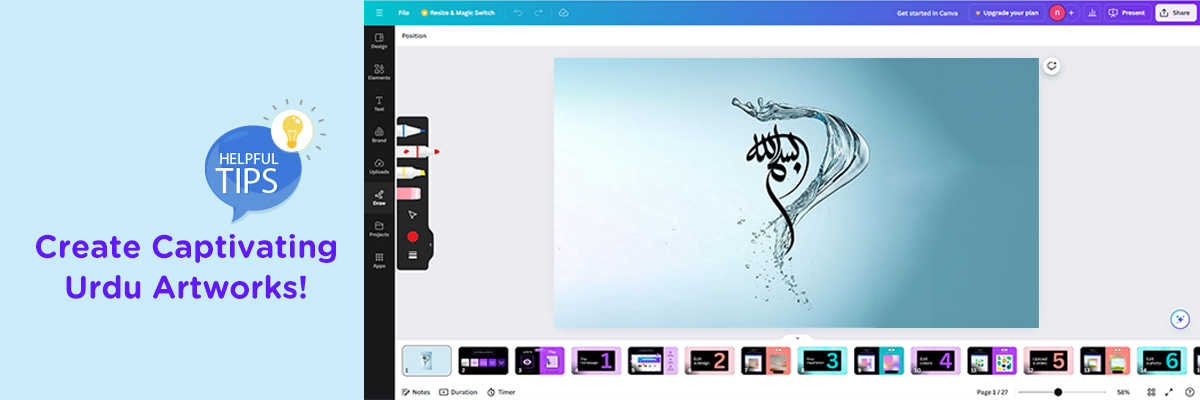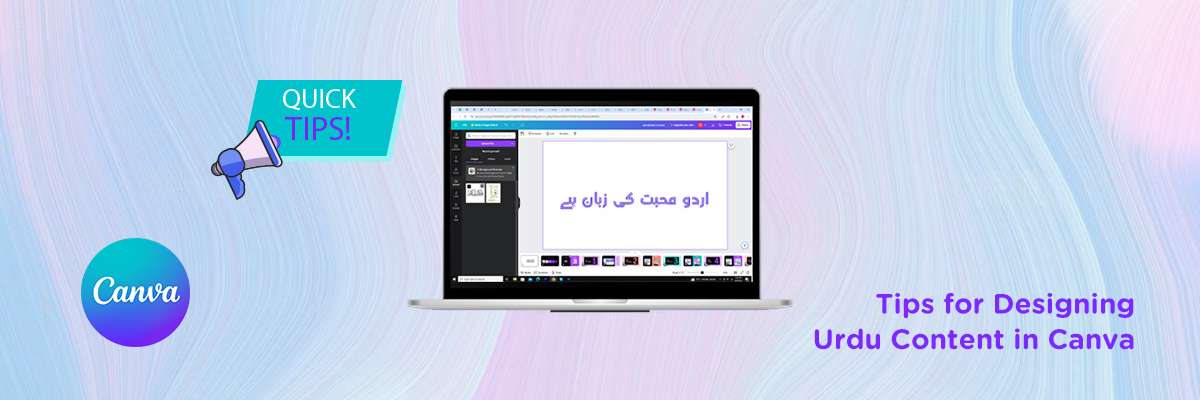Creating Urdu content in Canva can be both rewarding and challenging, especially when you want to ensure your designs are not only visually appealing but culturally appropriate as well. Although Canva provides ready-to-use elements for designing posts, cards, posters, etc., customizing them according to your needs can be difficult, especially when it comes to Urdu typography. There are a lot of things that need to be considered while crafting design projects for a specific group of people. As Urdu is the native language of Pakistanis and, to some extent, Indians, therefore the designs we make must be according to them, whether we’re pitching an idea or simply conveying a message. Choosing the right font is one thing, but in this guide, we are going to discuss what other considerations must be taken into account while designing media for Urdu-speaking audiences. So, sit still and learn about our seven useful tips to help you design Urdu content using Canva effectively. Moreover, check out our carefully curated collection of 25 Urdu Fonts for Canva artworks.
7 Thoughtful Tips for Canva Urdu Content And Artwork
Designing Urdu content in Canva can be an exciting process, as it allows you to combine creativity with linguistic and cultural sophistication. From deciding to designing, we are going to make this process smooth and effective. Here are seven useful tips to help you make the most of Urdu fonts and text in your designs:

Research First, Then Design
Before you begin to design or create anything, it’s a good idea to learn, read, research, and use resources. Through research is key for a successful outcome, whether you’re gathering materials or information. As your target audience is mostly South Asians, it would be better to use design schemas that align with them. Colors play an important part in that, therefore, go for the colors that contrast well with the background and align with your audience to make your text stand out and attention-grabbing.
Choose the Right Font
Urdu typography is unique, so selecting the right font is crucial. A font is like the backbone of your design; a little inappropriation can make your whole design look absurd. Canva offers various built-in Urdu fonts, but you should choose one that suits the tone and purpose of your content. You can download them online from various reliable Urdu Font Resources, like Google Fonts, Urdufonts.com, and more. For formal or literary content, consider using fonts like Nastaliq, which is known for its elegant and flowing style. For more modern and straightforward designs, Naskh might be a better fit.
Limit your Typefaces
A big mistake that some of us make while designing is to overwhelm the artboard with a handful of fonts and styles. Using 2,3 appropriate fonts is better than overloading it with ten different typefaces. However, if you want the variation, use Urdu Font Families with a variety of weights. This way, you can create a difference in design with weights rather than using entirely different fonts that can complicate the outlook. Some famous font families are Swissra, Doran, Al Jazeera, and more.
Show Visual Hierarchy
To enhance the visual appeal and effectiveness of your design, design your template in a way that hierarchy of information is clear, meaning ensure that readers don’t have to ponder which text comes first or hold weight, it must be clear. Use different font sizes, weights, and styles to differentiate headings, subheadings, and body text. This technique helps guide the reader’s eye through the content smoothly. Also, learn about some Canva Graphic Design Techniques for beginners.
Utilize Text Alignment and Spacing
Since Urdu is written from right to left, make sure to align your text boxes accordingly. Canva allows you to adjust text alignment, so set it to right-aligned to maintain the natural flow of Urdu text. This alignment helps maintain the visual balance of your design. Moreover, proper letter spacing and line height are essential for maintaining readability in Urdu typography. Too much or too little space can make the text difficult to read. Use Canva’s text spacing tools to adjust these elements and ensure that letters and words are distinct and clear.

Ensure Readability
When designing Urdu content, prioritize readability. Adjust the font size to ensure that the text is clear and legible on different devices and platforms. Avoid overly decorative fonts for body text, as they can hinder readability, especially in smaller sizes. You can also improve readability by omitting the excessive use of design elements. This way, your text will have more space and capture the reader’s attention at first glance. Also, read our guide to choosing Legible Urdu Fonts for digital writing purposes.
Use Cultural Elements
Canva offers a wide range of templates that can be customized for Urdu content. Start with a template that suits your purpose and modify it to include Urdu text. This can save time and provide inspiration for layout and design elements. To make your Urdu design more relatable, add some cultural elements such as patterns, motifs, or imagery relevant to the Urdu-speaking audience. This approach not only improves the design but also adds authenticity and emotional appeal to your content.
Challenges While Designing Urdu Content in Canva
Creating Urdu content in Canva can sometimes be a bit difficult due to the unique nature of the Urdu script. Earlier we have discussed some tips for Canva Urdu content designing now let’s look into some common problems faced by designers. Here are some common challenges users face and their practical solutions to help streamline the design process. These solutions can help you deal with the complexities of designing Urdu content in Canva, ensuring you a smooth work process.
| No. | Challenge | Solution |
|---|---|---|
| 1. | Font Compatibility | Import compatible Urdu fonts from external sources. Ensure the font files are in a format supported by Canva, such as TTF or OTF. |
| 2. | Text Alignment | Use Canva’s text alignment tools to set text direction to right-to-left. Adjust spacing manually to ensure proper flow and alignment. |
| 3. | Limited Urdu Templates | Customize existing templates by adding Urdu text and cultural elements. Save your designs as templates for future use to save time. |
| 4. | Complex Typography | Choose fonts that accurately represent Urdu ligatures. Test different fonts to find the best representation for your content and style. |
| 5. | Resolution Issues | Export designs in high resolution and use vector-based elements where possible. Double-check text clarity before finalizing your design. |
Bottom Line
Designing Urdu content in Canva presents unique challenges, but these can be effectively managed with strategic approaches. By selecting the right fonts, paying attention to little details like text alignment, and utilizing Canva’s customization features, designers can create the content that is desirable and functional. Experimenting with font combinations, using cultural elements, and maintaining design consistency can totally lift the whole aesthetic and communicative power of your designs. At urdufonts.com we try our best to highlight challenges faced by designers while working on Urdu typography and offer them their viable solutions. In this way, we make a collective effort to revive and flourish our mother language digitally. So, stay tuned and keep on exploring and reading our guides and collection to get valuable insights!



